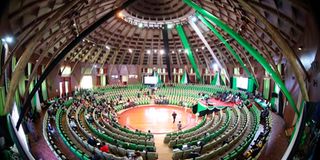How IEBC will transmit poll results

Stakeholders attend the simulation of results streaming by IEBC ahead of the August 9 polls at Bomas of Kenya on July 19, 2022.
What you need to know:
- An analysis of the test done yesterday indicated that after one hour, results from 500 polling stations had been transmitted.
- This means that if the same speed is used on the actual voting day, then it will take 100 hours to transmit results from all polling stations, meaning that Kenyans will know the final results after four days.
The Independent Electoral and Boundaries Commission (IEBC) has outlined a four-step verification of results from polling stations before they are displayed on the national tallying centre screens.
In its second dry run of electronic transmission of results conducted yesterday, the commission outlined verification of the presiding officers’ digital signature and thumbprint, authentication of the Kiems codes and Sim cards of a particular station before displaying the final results of a polling station.
In yesterday’s test, the commission transmitted results from 580 polling stations spread across the country, but mostly only results from Nairobi stations were transmitted in real-time.
Results from 12 polling stations in Mandera County were not transmitted after the commission got information in the middle of the simulation that the fibre optic system had been interfered with.
Nevertheless, the commission assured Kenyans it has sealed all loopholes that might interfere with the transmission of the results.
QR Codes
In the enhanced features, the commission said it would use ultraviolet light to check the security of the forms 34A that will be physically delivered to the national tallying centre.
The forms will also contain quick response (QR) codes to ensure no form that does not belong to IEBC is sent to the tallying centre.
This was in response to questions by agents on whether a form other than the one containing the actual results from the polling station can be sent to the national tallying centre and the results announced by the commission as final.
To further secure the results of the August 9 elections, the Kiems kits that will be used to transmit results have been configured to reject results from other polling stations.
The kits will not transmit results of forms 34A that have a security feature different from the one of the polling stations it is configured to handle.
The kits will also demand a digital signature and biometrics of the presiding officer before sending the picture of form 34A containing presidential election results.
“There is no way a form with fake results can be sent using our kits because it will automatically be detected,” Mr Michael Ouma, the commission’s ICT director said.
Commissioner Justus Nyang’aya, who is in charge of ICT, said the commission was not taking any chances as far as delivering a credible poll is concerned.
“This exercise is important to us. We have taken those steps to ensure the votes of the people are protected,” Mr Nyang’aya said.
Further, upon completion of voting, the presiding officer will only send the presidential results to the national tallying centre upon agreement by all the agents.
Once a result is sent to the national tallying centre, it will not be displayed until it is confirmed that it is from a valid polling station, a registered IEBC device and has been sent using a registered Sim card.
Challenges
The dry run was designed to pick out challenges in the transmission of electronic copies of election results, which are used to collate provisional election results at the national tallying centre at the Bomas of Kenya, Nairobi.
Electronically transmitted results are only used to generate a provisional tally.
The IEBC is required to verify physical statutory forms before declaring the outcome of an election.
An analysis of the test done yesterday indicated that after one hour, results from 50 polling stations had been transmitted.
This means that if the same speed is used on the actual voting day, then it will take 100 hours to transmit results from all polling stations, meaning that Kenyans will know the final results after four days.
However, the commission still failed to demonstrate how results from 1,111 polling stations not covered by the 3G network will be transmitted.
Commissioner Abdi Guliye said that only presidential agents will be shown how the results from those stations will be transmitted.
“We will do an in-house exercise with presidential agents in our warehouse to demonstrate the transmission of results in those areas without network,” Prof Guliye said.
The commission also failed to show how the kits will reject a falsified form 34A, only saying its clerks have been trained to do the right thing.





